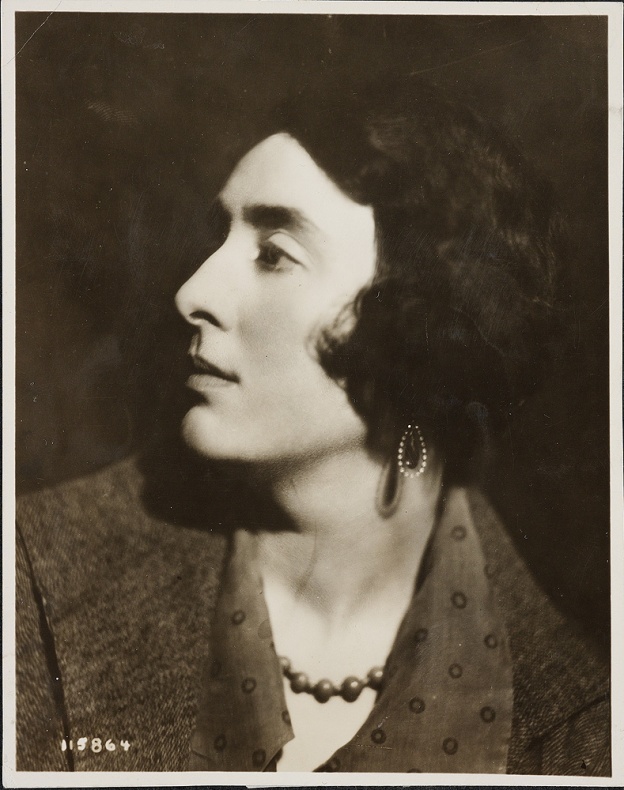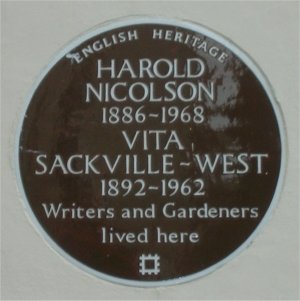
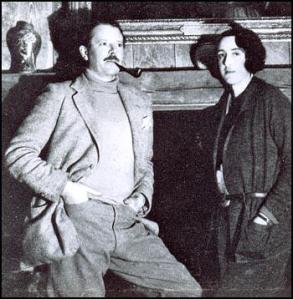
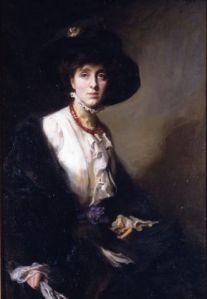
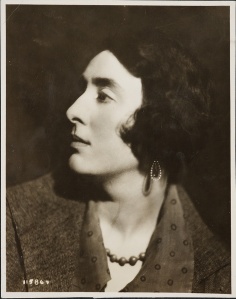
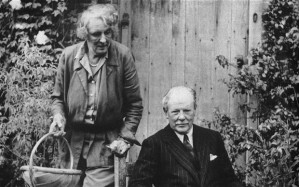
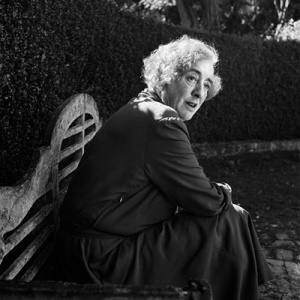
The Hon Victoria Mary Sackville-West, Lady Nicolson, (9 March 1892 – 2 June 1962), best known as Vita Sackville-West, was an English author, poet and gardener. She won the Hawthornden Prize in 1927 and 1933. She was known for her exuberant aristocratic life, her passionate affair with the novelist Virginia Woolf, and Sissinghurst Castle Garden, which she and her husband, Sir Harold Nicolson, created at their estate.
Early life
Victoria Sackville-West (known as Vita) was born at Knole House near Sevenoaks, Kent, the only child of Lionel Edward Sackville-West, 3rd Baron Sackville and his wife Victoria Sackville-West, who were cousins. Her mother was the natural daughter of Lionel Sackville-West, 2nd Baron Sackville. Christened Victoria Mary Sackville-West, she was known as “Vita” throughout her life, to distinguish her from her mother.
The usual English aristocratic inheritance customs were followed by the Sackville family, which prevented Vita from inheriting Knole on the death of her father. The house followed the title, and was bequeathed instead by her father to his nephew Charles, who became the 4th Baron. The loss of Knole would affect her for the rest of her life; of the signing in 1947 of documents relinquishing any claim on the property, part of its transition to the National Trust, she wrote that “the signing… nearly broke my heart, putting my signature to what I regarded as a betrayal of all the tradition of my ancestors and the house I loved.”
Personal life
Marriage
In 1913, at age 21, Vita married the 27-year-old writer and politician Harold George Nicolson (21 November 1886 – 1 May 1968) in the private chapel at Knole. Nicknamed Hadji, he was the third son of British diplomat Arthur Nicolson, 1st Baron Carnock (1849–1928). The couple had an open marriage. Both Sackville-West and her husband had same-sex relationships, as did some of the people in the Bloomsbury Group of writers and artists, with many of whom they had connections.
These affairs were no impediment to the closeness between Sackville-West and Nicolson, as is seen from their almost daily correspondence (published after their deaths by their son Nigel), and from an interview they gave for BBC radio after World War II. Harold Nicolson gave up his diplomatic career partly so that he could live with Sackville-West in England, uninterrupted by long solitary postings abroad.
Following the pattern of his father’s career, Harold was at different times a diplomat, journalist, broadcaster, Member of Parliament, and author of biographies and novels. The couple lived for a number of years in Cihangir, Constantinople, and were present, in 1926, at the coronation of Rezā Shāh, in Tehran, Persia. They returned to England in 1914 and bought Long Barn in Kent, where they lived from 1915 to 1930. They employed the architect Edwin Lutyens to make many improvements to the house.
The couple had two children: Nigel (1917–2004), a well known editor, politician, and writer, and Benedict (1914–1978), an art historian. In the 1930s, the family acquired and moved to Sissinghurst Castle, near Cranbrook, Kent. Sissinghurst had once been owned by Vita’s ancestors, which gave it a dynastic attraction to her after the loss of Knole. There the couple created the famous gardens that are now run by the National Trust.
Affairs and bisexuality
Rosamund Grosvenor
Vita’s first close friend was Rosamund Grosvenor (5 September 1888 – 30 June 1944), who was four years her senior. She was the daughter of Algernon Henry Grosvenor (1864–1907), and the granddaughter of Robert Grosvenor, 1st Baron Ebury. Vita met Rosamund at Miss Woolf’s school in 1899, when Rosamund had been invited to cheer Vita up while her father was fighting in the Boer war. Rosamund and Vita later shared a governess for their morning lessons. As they grew up together, Vita fell in love with Rosamund, whom she called ‘Roddie’ or ‘Rose’ or ‘the Rubens lady’. Rosamund, in turn, was besotted with Vita. “Oh, I dare say I realized vaguely that I had no business to sleep with Rosamund, and I should certainly never have allowed anyone to find it out,” she admits in her journal, but she saw no real conflict: “I really was innocent.”
Lady Sackville, Vita’s mother, invited Rosamund to visit the family at their villa in Monte Carlo; Rosamund also stayed with Vita at Knole, at Rue Lafitte, and at Sluie. During the Monte Carlo visit, Vita wrote in her diary, “I love her so much.” Upon Rosamund’s departure, Vita wrote, “Strange how little I minded [her leaving]; she has no personality, that’s why.” Their secret relationship ended in 1913 when Vita married. Rosamund died in 1944 during a German V1 rocket raid.
Violet Trefusis
The same-sex relationship that had the deepest and most lasting effect on Sackville-West’s personal life was with the novelist Violet Trefusis, daughter of the Hon. George Keppel and his wife, Alice Keppel, a mistress of King Edward VII. They first met when Vita Sackville-West was 12 and Violet was 10, and attended school together for a number of years.
The relationship began when they were both in their teens. Both later married. Vita and Trefusis had eloped several times from 1918 on, mostly to France, Sackville-West dressing as a man when they went out, as the French writer George Sand (Amandine Aurore Lucie Dupin, Baroness Dudevant, 1804–1876), had done some 100 years earlier when residing with the Polish musician Frédéric Chopin (1810–1849) and her own two children on the Spanish island of Majorca in 1838 and early 1839.
The affair ended badly, with Trefusis pursuing Sackville-West to great lengths until Sackville-West’s affairs with other women finally took their toll.
The two women seem to have made a bond to remain faithful to one another, meaning that although both were married, neither could engage in sexual relations with her own husband. Sackville-West was prompted to end the affair when she heard allegations that Trefusis had been involved sexually with her husband, indicating that she had broken their bond. Despite the rift, the two women were devoted to one another, and deeply in love, and continued to have occasional liaisons for a number of years afterwards, but never rekindled the affair.
Vita’s novel Challenge also bears witness to this affair: Sackville-West and Trefusis had started writing this book as a collaborative endeavour, and the male character’s name, Julian, had been Sackville-West’s nickname when passing as a man. Her mother, Lady Sackville, found the portrayal obvious enough to refuse to allow publication of the novel in England; but Vita’s son Nigel Nicolson (1973, p. 194) praises his mother: “She fought for the right to love, men and women, rejecting the conventions that marriage demands exclusive love, and that women should love only men, and men only women. For this she was prepared to give up everything… How could she regret that the knowledge of it should now reach the ears of a new generation, one so infinitely more compassionate than her own?”
Virginia Woolf
The affair for which Sackville-West is most remembered was with the prominent writer Virginia Woolf in the late 1920s. Woolf wrote one of her most famous novels, Orlando, described by Sackville-West’s son Nigel Nicolson as “the longest and most charming love-letter in literature”, as a result of this affair.
Unusually, the moment of the conception of Orlando was documented: Woolf writes in her diary on 5 October 1927: “And instantly the usual exciting devices enter my mind: a biography beginning in the year 1500 and continuing to the present day, called Orlando: Vita; only with a change about from one sex to the other” (excerpt from her diary published posthumously by her husband Leonard Woolf).
Other affairs
Vita Sackville-West also had a passionate affair between 1929 and 1931 with Hilda Matheson, head of the BBC Talks Department. “Stoker” was the pet name given to Hilda by Sackville-West during their liaison.
In 1931 Sackville-West became involved in a ménage à trois with journalist Evelyn Irons, who had interviewed her after her novel The Edwardians became a bestseller, and Irons’s lover Olive Rinder.
One of Vita’s suitors was Henry Lascelles who married the Princess Royal and became 6th Earl of Harewood.
She was also romantically involved with her sister-in-law Gwen St. Aubyn, Mary Garman and others not listed here.
Well-known writings
The Edwardians (1930) and All Passion Spent (1931) are perhaps her best known novels today. In the latter, the elderly Lady Slane courageously embraces a long suppressed sense of freedom and whimsy after a lifetime of convention. This novel was dramatized by the BBC in 1986 starring Dame Wendy Hiller.
Sackville-West’s science-fantasy Grand Canyon (1942) is a “cautionary tale” (as she termed it) about a Nazi invasion of an unprepared United States. The book takes an unsuspected twist, however, in that makes it something more than a typical invasion yarn.
In 1947 Sackville-West was made a Companion of Honour for her services to literature. The same year she began a weekly column in The Observer called “In your Garden”. In 1948 she became a founder member of the National Trust’s garden committee.
She is less well known as a biographer, and the most famous of those works is her biography of Saint Joan of Arc in the work of the same name. Additionally, she composed a dual biography of Saint Teresa of Ávila and Thérèse of Lisieux entitled The Eagle and the Dove, a biography of the author Aphra Behn, and a biography of her own grandmother, the Spanish dancer known as Pepita., the mother of many children by British diplomat and second Lord Sackville, Lionel Sackville-West, (1829–1908), as stated extensively above, running by 2010 at some 11 editions in English. For instance, the 1985 edition by Telegraph Books, (ISBN 9780897607858). The first edition was Doubleday Publishers, 1937. There was another by Amereon, date unknown, (ISBN 9780848811501).
Her long narrative poem, The Land, won the Hawthornden Prize in 1927. She won it again, becoming the only writer to do so, in 1933 with her Collected Poems.
Legacy
Vita died at Sissinghurst on the 2nd June 1962 and Sissinghurst Castle is now owned by the National Trust, given by Sackville-West’s son Nigel in order to escape payment of inheritance taxes. Its gardens are famous and remain the most visited in all of England.
A recording was made of Vita Sackville-West reading from her poem The Land. This was on four 78rpm sides in the Columbia Records ‘International Educational Society’ Lecture series, Lecture 98 (Cat. no. D 40192/3).
An English Heritage plaque on their house in Ebury Street, London SW1, commemorates her and Harold Nicolson.
Her cremated remains were placed in the Sackville family vault at Withyham Parish Church in East Sussex.












































